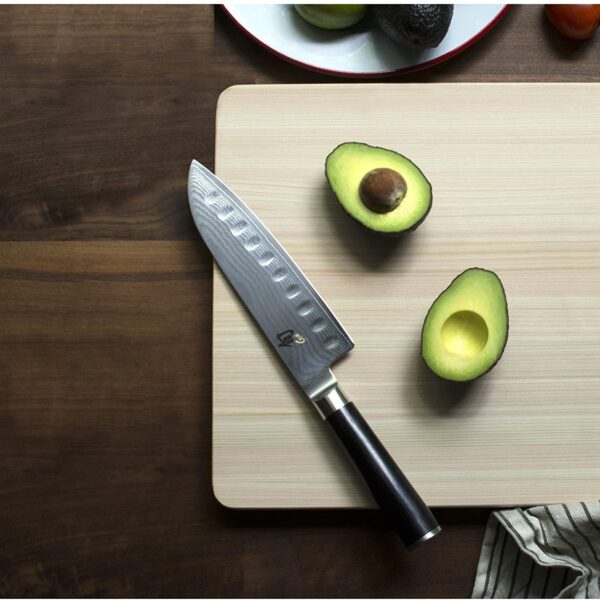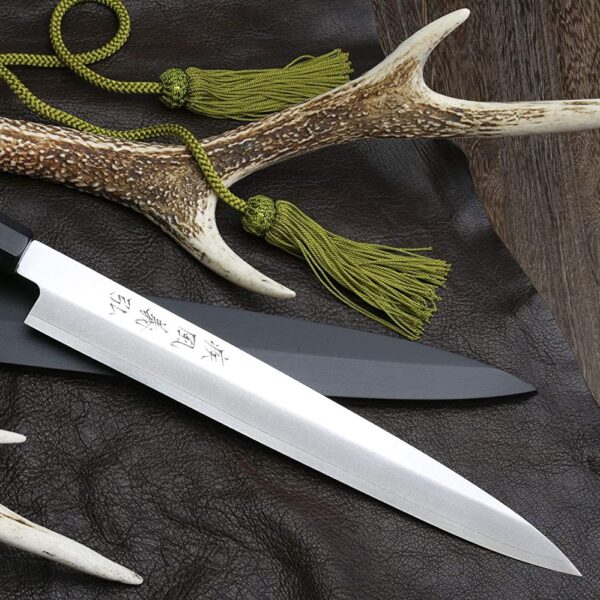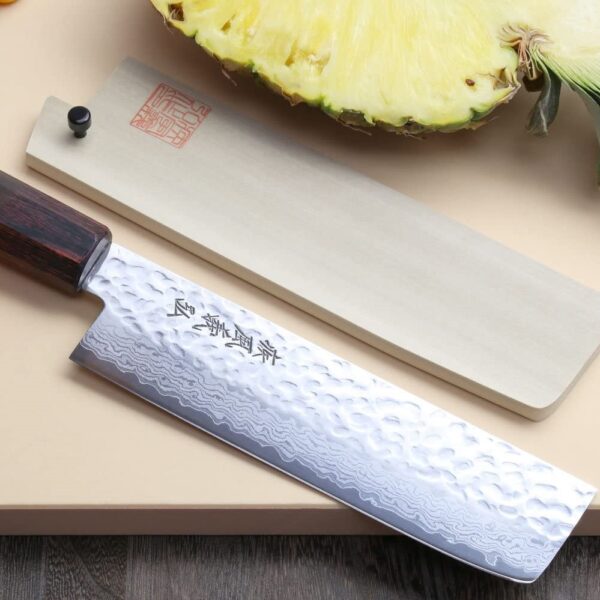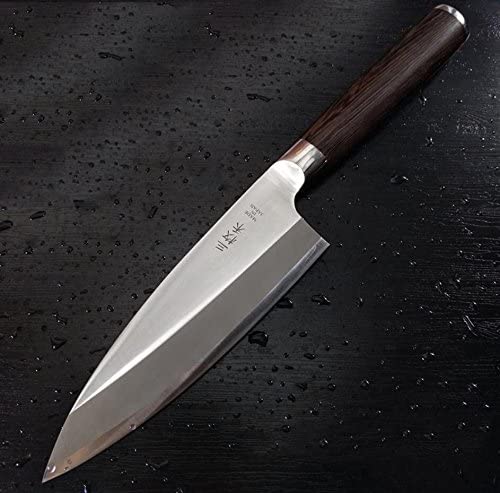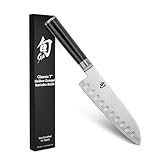Only 10% of the world’s population are left-handed. That’s not an insignificant amount by any means. However, it does also mean that in the field of design and ergonomics, lefties often get left behind. It’s evident with the way that various everyday items are constructed. Pens, car gear shifts, pant zippers, can openers, desk armchairs, scissors, guitars, camera shutter buttons, and of course… knives. In this article, we discuss left handed Japanese knives – including what’s available in the market and where to buy.
What are you looking for? Click on a knife type to skip down 👇
Note: this article includes both double-bevel / ambidextrous knives & single-bevel left-handed knives.
The Plight Of Lefties…
It’s an unfortunate fact that a lot of the things that we rely on to stay productive on a daily basis are designed for right-handers. For the most part, this is a struggle that lefties have to contend with every day.
And for righties, it’s a complete afterthought. They don’t pay attention to such details at all. When a rightie wants to buy whatever kitchen knives they want right off the rack without caring about whether it’s made for their hand or not.
However, lefties are always left to either really scavenge for specialized knives or settle for a knife that wasn’t made for them. You would never see any consumer product labeled, “This was designed for right-handed people.” But these are the kinds of labels that lefties always have to look for when buying certain things.
Double-Bevel vs Single-Bevel
Not many people realize that there are left-handed or right-handed knives to begin with. It’s probably only those who really take their knife usages very seriously who notice slight hints of discomfort and impracticality.
Also, a lot of knives these days are designed to be ambidextrous in nature. This means that they are designed to be comfortable for both left and right-handed people.
You might be asking yourself what makes a knife left-handed, right-handed, or ambidextrous to begin with? Well, for the most part, it has to do with how the edges of the knives are laid out.
Double-Beveled Knives
To put it simply, a beveled knife is what its name implies. It’s a knife with a blade that has bevels on both sides. When you look at the blade from a top perspective, you will see that both sides are slanted and sharpened equally.
This means that the knife has a blade that is equipped for both lefties and righties. The double-beveled knife is typically known as the ambidexter knives as it allows for comfortable use by both left-handed and right-handed individuals.
Pros and Cons
Pros:
- Versatile knife that can be used by both lefties and righties
- Easily available as most knives are constructed this way
- Multi-purpose knife that be used for a variety of situations
Cons:
- Structure of the blade doesn’t allow for ultraprecise thin slicing
- Food tends to stick to the blade after cutting
- Both sides of the knife have to be sharpened equally to maintain effectiveness
Single-Beveled Knives
On the other side of the spectrum, you have single-beveled knives. These are the knives that are slanted and sharpened on only one side. So, when you are looking at the blade from a top perspective, you will see that the blade has an asymmetric oblique cut.
These single-beveled knives tend to not be very popular among the masses. However, they are a go-to for chefs and culinary enthusiasts who look for precision slicing instruments.
These kinds of knives evoke the traditional Japanese katana swords that were used by ancient Samurai and Ninjas. This contributes to its popularity in traditional Eastern culinary arts. Since the blades are only slanted on one side, then that particular side is the only one that requires sharpening.
Traditionally, single-beveled knives are designed for a particular dextrous identity. So, if you’re left-handed, you wouldn’t be able to use a right-handed single-beveled knife effectively.
Most of the single-beveled knives that are manufactured and produced these days tend to be designed mostly for righties. However, there are some manufacturers that produce specialty single-beveled knives that are designed for left-handed people as well.
Pros and Cons
Pros:
- Optimal knife for thin slicing due to its sharper blade
- Ideal for peeling and performing decorative cuts
- Ideal knife for filleting fish as it is effective at removing bones and peeling skin
- Easier to sharpen and maintain
Cons:
- Not good for vertical slicing due to imbalanced blade
- Not as versatile as the double-beveled knife
- Left-handed single-beveled knives are harder to find
Best Knives for Lefties
So without further ado, let’s get into the product recommendations. Again, please remember: double-bevel knives are ambidextrous, and as such are included here. Actually, the vast majority of these are double-bevel (with exceptions, e.g. sashimi knives). If you are ever looking for a single-bevel knife, that’s when you need to be extra careful as a leftie.
Ambidextrous Gyuto Knives
When talking left handed Japanese knives, let’s start with the gyuto. The gyuto or chef’s knife is typically what you would consider to be an all-around knife. It’s a versatile knife that’s capable of doing everything in the kitchen including chopping, slicing, and dicing.
If you don’t plan on splurging on a large collection of knives, and you need just a few essentials, a gyuto is a definite must-have. If you’re only going to buy one knife for regular use, make it a gyuto knife.
- Professional Chef Knife
- Made in Japan
- Hand Made Samurai Style
- JAPANESE CHEF KNIFE: The Shun Classic 8-inch Chef's Knife is expertly designed for a variety of...
- PIONEERING EXCELLENCE: Bring home a piece of the renowned Classic Series – the original authentic...
- SUPERIOR SHARPNESS: Crafted with VG-MAX steel and 68 layers of Damascus cladding, this knife...
- Blade Material: VG10 Stainless Steel / Edge Angle: Double Edged / Grade: Damascus / Shape: Octagonal...
- Forged and hammered with 46 layers of steel in the Damascus tradition with a VG10 Core, the VG10...
- The most versatile and essential of all knives a cook can have is a Japanese chefs knife known as a...
If you’re looking for more budget options, check out this article to choose a budget gyuto knife for <$90.
Santoku Knives
Left handed Japanese knives also include the santoku. A santoku is very much like a gyuto in the sense that it is a knife that’s designed to be versatile and multi-purpose. However, it differs from the traditional gyuto with the shape of its blade. The chef’s knife typically has a pointed tip whereas the santoku knife has a curve running along the spine of the blade towards the edge.
- ALL PURPOSE KITCHEN KNIFE: The Shun Classic 7-inch Hollow Ground Santoku Knife is expertly designed...
- PIONEERING EXCELLENCE: Bring home a piece of the renowned Classic Series – the original authentic...
- SUPERIOR SHARPNESS: Crafted with VG-MAX steel and 68 layers of Damascus cladding, this knife...
- ALL PURPOSE KITCHEN KNIFE: The Shun Premier 7-inch Santoku Knife is expertly designed for slicing...
- DISTINCTIVE HAMMERED FINISH: Part of the Premier Series, this knife features a beautiful hammered...
- SUPERIOR SHARPNESS: Crafted with VG-MAX steel and 68 layers of Damascus cladding, this knife...
- 2.5mm blade
- Razor-sharp edge
- Sub-zero tempered steel retains its edge better than original steel
Sashimi / Yanagiba Knives
A sashimi knife, also known as yanagi or yaganiba, as its name suggests is a knife that is designed for slicing sashimi. This is a traditional Japanese dish that typically consists of small slices of raw meat served with soy sauce and wasabi.
A dedicated sashimi knife or yagani consists of a single bevel and are typically designed to have very thin blades for precise slicing. Most yanagi knives are made out of carbon steel. This is another great option when it comes to left handed Japanese knives.
Reminder: these really are left-handed, not ambidextrous.
- Razor sharp
- Stays sharper longer
- Perfectly balanced
- The yanagi shape is a Japanese specialty knife for slicing sashimi
- Left-handed design
- Superior balance between durability and sharp cutting edge
Usuba Knives
The usuba literally translates to having a thin blade. So, as you may have guessed, an usuba knife is one with a very thin blade and is used mostly by professionals to cut vegetables. The usuba is normally used for very specific purposes due to its unusual height and straight edges.
- Blade Material: VG10 Stainless Steel / Edge Angle: Double Edged / Grade: Damascus / Handle Shape:...
- Forged and hammered with 46 layers of steel in the Damascus tradition with a VG10 Core, the VG10...
- One of the most popular knives that a cook can have today is a Japanese Vegetable knife known as a...
Comment on this for clarification ☝. It is indeed a double-bevel knife, suitable for both left and right handers. Some confusion has arisen due to the 70/30 micro-bevel edge.
Comment from the manufacturer: “The blade of this knife would be suited for both lefties and righties since the micro-bevel on top is so insignificant that it would not affect the actual 50/50 construct of the blade”
No products found.
Nakiri Knives
The nakiri knife or the nakiri bocho is a traditionally Japanese-style knife. It’s designed as a knife that specializes in chopping vegetables. Its most notable features include having straight blade edges and squared tips.
When designed properly, a nakiri knife enables the user to cut all the way through a vegetable without exerting any horizontal pushing or pulling force.
- SPECIALIZED VEGETABLE KNIFE: The Shun Premier 5.5-inch Nakiri Knife is expertly designed for slicing...
- DISTINCTIVE HAMMERED FINISH: Part of the Premier Series, this knife features a beautiful hammered...
- SUPERIOR SHARPNESS: Crafted with VG-MAX steel and 68 layers of Damascus cladding, this knife...
- Powerhouse Nakiri: Masterfully elegant, perfectly balanced, razor sharp and with exceptional...
- Peak Performance: Mercilessly sharp, the Phantom Series edge is painstakingly honed by experts...
- The Dalstrong Touch: Full tang and precision forged from a single piece of ice tempered,...
This Dalstrong knife is made in Germany, but is still very-much worth including as a recommended Nakiri knife for a very reasonable price.
- 2.5mm blade
- Pakka wood handle
- Made of MOLYBDENUM STEEL
Deba Knives
The deba knife is a Japanese knife with a pointed blade. Most chefs typically use the deba for slicing fish. However, it can also be used for slicing meat and poultry. While it is a knife that does well in heavy slicing tasks, it is not an advisable tool for slicing through bones.
- Razor sharp, high-carbon, no-stain German steel resists rust, corrosion, and discoloration
- Single-edge blade is taper ground with a fine stone finish
- for left Handed
- CROMOVA 18 stainless steel
- Rust, corrosion, & stain resistant
- Carefully weighted to ensure perfect balance and performance
Do Lefties Really Need Left-Handed Knives?
But, to be quite blunt about it, lefties don’t really NEED left-handed knives the same way they don’t really need left-handed guitars. Heck, Jimi Hendrix was able to make do with flipping a right-handed guitar upside down and he made a career out of it. As a leftie, you don’t NEED a left-handed knife. However, it does make the job a lot easier to accomplish.
Consider the amount of time and energy that is poured into the design and ergonomics of a knife’s handle. There are all sorts of studies, mockups, and experiments that go into designing how a handle is constructed.
When you don’t take a person’s dexterity components into consideration in the design of a knife, it can make for a rather unpleasant experience. Again, you don’t really need a left-handed knife. But if you’re going to spend a lot of money on a proper kitchen knife, you want to make sure that it’s one that fits your hand like a glove.
Conclusion
In this article, we touched on left handed Japanese knives. Mostly, it all boils down to personal preference. If you feel like you can get away with using an ambidextrous knife for the rest of your life, then do so by all means. That’s your prerogative. For some single-bevel knives for specific uses e.g. sashimi knives and usuba knives you’ll struggle without a specific left-hander.
But for the average home cook, chances are you may never need such specialist knives. Many people have gotten the job done with a versatile and multifunctional ambidextrous knife without much hassle.
But if you’re a leftie who is looking for cleaner, thinner, and more precise cuts, then you might want to look into more specialized options. Whatever the case, there’s bound to be a knife out there that serves your desired purpose.

